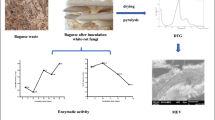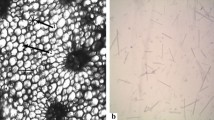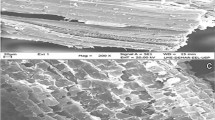Abstract
Sisal is a potential raw material for the production of bioproducts because it has high contents of cellulose and hemicellulose that generate fermentable sugars and can produce compounds of value for industrial use. The present study evaluates the structural composition of sisal bagasse to use it in the production of arabitol and xylitol. Sisal bagasse was characterized by determination of the moisture, pH, ash, soluble solids, extractives, alpha cellulose, holocellulose, hemicellulose and lignin. Electron microscopy and infrared and X-ray diffraction analyses were also performed. The cell growth of the yeast Debaryomyces hansenii in synthetic media was tested to determine the best conditions for the fermentation in the sisal bagasse hydrolysate. The results showed high amounts of hemicellulose (22.91%) in sisal bagasse biomass when compared to sugarcane and the conversion of hemicellulose, breaking into pentoses in the hydrolysed liquor from the sisal bagasse, was efficient (liquor rich in pentoses). These evidences were obtained through analytical determinations such as SEM and physical analyses of infrared and X-ray diffraction; in addition, the results showed that D. hansenii gave excellent arabitol production (1.14 g L−1) values in the sisal bagasse hydrolysate medium, thus demonstrating the importance of the biomass for obtaining bioproducts.





Similar content being viewed by others
References
Barreto ACH, Rosa DS, Fechine PBA, Mazzetto SE (2011) Properties of sisal fibers treated by alkali solution and their application into cardanol-based biocomposites. Compos Part A 42:492–500
Benitez-Guerrero M, López-Beceiro J, Sánchez-Jiménez PE, Pascual-Cosp J (2014) Comparison of thermal behavior of natural and hot-washed sisal fibers based on their main components: cellulose, xylan and lignin. TG–FTIR analysis of volatile products. Thermochim Acta 581:70–86
Botura MB, Dos Santos JDG, Da Silva GD, De Lima HG, De Oliveira JVA, De Almeida MAO, Batatinha MJM, Branco A (2013) In vitro ovicidal and larvicidal activity of Agave sisalana Perr. (Sisal) on gastrointestinal nematodes of goats. Vet Parasitol 192:211–217
Brasil (2008) Métodos físico-químicos para análise de alimentos. Instituto Adolfo Lutz, São Paulo
Carpio LGT, Souza FS (2017) Optimal allocation of sugarcane bagasse for producing bioelectricity and second generation ethanol in Brazil: scenarios of cost reductions. Renew Energy 111:771–780
Carvalho KCC, Mulinari DR, Voorwald HCJ, Cioffi MOH (2010) Preparação e caracterização de fibras de bagaço de cana modificadas com nanopartículas de óxido de zircônio. 19° Congresso Brasileiro de Engenharia e Ciência dos Materiais—CBECiMat, 7726–7734, Campos do Jordão, SP
Chen H (2014) Biotechnology of lignocellulose: theory and practice. Chemical Industry Press, Bei**g and Springer Science Business Media, Dordrecht
Debnath M, Pandey M, Sharma R, Thakur GS, Lal P (2010) Biotechnological intervention of Agave sisalana: a unique fiber yielding plant with medicinal property. J Med Plants Res 43:177–187
FAOSTAT (2019) Food and Agriculture Organization of the United Nations, Sisal Crops. Available in http://www.fao.org/faostat/en/#data/QC/visualize/. Accessed 10 Feb 2019
Ferreira SR, Silva FA, Lima PRL, Filho RDT (2015) Effect of fiber treatments on the sisal fiber properties and fiber-matrix bond in cement based systems. Construct Build Mater 101:730–740
Fiore V, Scalici T, Nicoletti F, Vitale G, Prestipino M, Valenza A (2016) A new eco-friendly chemical treatment of natural fibres: effect of sodium bicarbonate on properties of sisal and its epoxy composites. Compos Part B 85:150–160
Girio FM, Amaro C, Azinheira H, Pelica F, Amaral- Collaço MT (2000) Polyols production during single and mixed substrate fermentations in Debaryomyces hansenii. Bioresour Technol 7:245–251
Hernández-Meléndez O, Miguel-Cruz F, Montiel C, Hernández-Luna M, Vivaldo-Lima E, Mena-Brito C, Bárzana E (2016) Characterization of blue agave bagasse (BAB) as raw material for bioethanol production processes by gravimetric, thermal, chromatographic, x-ray diffraction, microscopy, and laser light scattering techniques. Bioenergy Res 1–13
Himabindu K, Gummadi SN (2015) Effect of kLa and Fed-batch strategies for enhanced production of xylitol by Debaryomyces nepalensis NCYC 3413. Br Biotechnol J 5:24–36
Ishmayanaa S, Kennedya UJ, Learmontha RP (2015) Preliminary evidence of inositol supplementation effect on cell growth, viability and plasma membrane fluidity of the yeast Saccharomyces cerevisiae. Procedia Chem 17:162–169
Koganti S, Ju L (2013) Debaryomyces hansenii fermentation for arabitol production. Biochem Eng J 79:112–119
Kordowska-Wiater M (2015) Production of arabitol by yeasts: current status and future prospects. J Appl Microbiol 119:303–314
Kordowska-Wiater M, Targonski Z, Jarosz A (2008) Biotransformation of L-arabinose to arabitol by yeasts from genera Pichia and Candida. Biotechnologia 1:177–188
Krishnan KA, Josec C, Ra RK, George KE (2015) Sisal nanofibril reinforced polypropylene/polystyrene blends: morphology, mechanical, dynamic mechanical and water transmission studies. Ind Crops Prod 71:173–184
Kumar R, Singh S, Singh OV (2008) Bioconversion of lignocellulosic biomass: biochemical and molecular perspectives. J Ind Microbiol Biotechnol 35:377–391
Kumdam H, Murthy SN, Gummadi SN (2013) Production of ethanol and arabitol by Debaryomyces nepalensis: influence of process parameters. AMB Express 3:1–12
Lima FCS, Silva FLH, Gomes JP, Silva Neto JM (2012) Chemical composition of the cashew apple bagasse and potential use for ethanol production. Adv Chem Eng Sci 2:519–523
Lima CSS, Conceição MM, Silva FLH, Lima EE, Conrado LS, Leão DAS (2013) Characterization of acid hydrolysis of sisal. Appl Energy 102:254–259
López-Linares JC, Romero I, Cara C, Castro E, Mussato SI (2018) Xylitol production by Debaryomyces hansenii and Candida guilliermondii from rapeseed straw hemicellulosic hydrolysate. Bioresour Technol 247:736–743
Martin AR, Mattoso LHC, Martins MA, Silva ORRF (2009) Caracterização química e estrutural de fibra de sisal da variedade Agave sisalana. Polímeros Ciência e Tecnologia 19(1):40–46
Medeiros LL, Silva FLH, Conceição MM, Conrado LS, Madruga MS, Costa WA, Bezerra TKA (2018) Efficient hydrolysis of cellulosic biomass into free sugars for a future development processing a biorefinery context. Biocatal Agric Biotechnol 16:448–452
Miranda CS, Fiuza RP, Carvalho RF, José NM (2015) Efeito dos tratamentos superficiais nas propriedades do bagaço da fibra de piaçava, Attalea funifera Martius. Quim Nova 38:161–165
Mooradian AD, Smith M, Tokuda M (2017) The role of artificial and natural sweeteeners in reducing the consumption of table sugar: a narrative review. Clin Nutr ESPEN 18:1–8
Ojeda K, Ávila O, Suárez J, Kafarov V (2011) Evaluation of technological alternatives for process integration of sugarcane bagasse for sustainable biofuels production—part 1. Chem Eng Res Des 89:270–279
Oliveira MB, Abreu HS, Pereira RPW (2009) Teor de Lignina em Plantas de Eucalyptus urophylla S. T. Blake Tratadas com Fitorreguladores. Silva Lusitana 17:51–57
Peng X, Zhong L, Ren J, Sun R (2010) Laccase and alkali treatments of cellulose fibre: surface lignin and its influences on fibre surface properties and interfacial behaviour of sisal fibre/phenolic resin composites. Compos A 41:1848–1856
Prakasham RS, Rao RS, Hobbs PJ (2009) Current trends in biotechnological production of xylitol and future prospects. Curr Trends Biotechnol Pharm 3:8–36
Rao LV, Goli JK, Gentela J, Koti S (2016) Bioconversion of lignocellulosic to xylitol: na overview. Bioresour Technol 213:299–310
Sakdaronnarong C, Jonglertjunya W (2012) Rice straw and sugarcane bagasse degradation mimicking lignocellulose decay in nature: an alternative approach to biorefinery. Sci Asia 38:364–372
Santa Anna LM, Sebastian GV, Menezes EP, Alves TLM, Santos AS, Pereira JRN, Freire DMG (2002) Production of biosurfactants from Pseudomonas aeruginosa PA1 isolated in oil environments. Braz J Chem Eng 19:159–166
Soleimani M, Tabil L (2014) Evaluation of biocomposite-based supports for immobilized-cell xylitol production compared with a free-cell system. Biochem Eng J 82:166–173
TAPPI (Technical Association of the Pulp and Paper Industry) (2011) Official test methods (OM), provisional test methods (PM) and useful test methods (UM). One Dunwoody Park, Atlanta
Thammasittironga SN, Chatwachirawongc P, Chamduanga T, Thammasittironga A (2017) Evaluation of ethanol production from sugar and lignocellulosic part of energy cane. Ind Crops Prod 108:598–603
Xavier FD, Bezerra GS, Santos SFM, Oliveira LSC, Silva FLH, Silva AJO, Conceição MM (2018) Evaluation of the simultaneous production of xylitol and ethanol from sisal fiber. Biomolecules 8:2–13
Xu F, Yu J, Tesso T, Dowell FE, Wang D (2013) Qualitative and quantitative analysis of lignocellulosic biomass using infrared techniques: a mini-review. Appl Energy 104:801–809
Yang ST, Yu M (2013) Bioprocessing technologies in biorefinery for sustainable production of fuels, chemicals and polymers, 1st edition. Wiley, New Jersey, pp 7–8
Yang L, Lu M, Carl S, Mayer AJ, Cushman JC, Tian E, Lin H (2015) Biomass characterization of Agave and Opuntia as potential biofuel feedstocks. Biomass Bioenergy 76:43–53
Zhang X, Liu L, Lin C (2014) Isolation, structural characterization and antioxidant activity of a neutral polysaccharide from Sisal waste. Food Hydrocolloids 39:10–18
Author information
Authors and Affiliations
Corresponding author
Additional information
Publisher's Note
Springer Nature remains neutral with regard to jurisdictional claims in published maps and institutional affiliations.
Rights and permissions
About this article
Cite this article
de Medeiros, L.L., da Silva, F.L.H., de Queiroz, A.L.M. et al. Structural-chemical characterization and potential of sisal bagasse for the production of polyols of industrial interest. Braz. J. Chem. Eng. 37, 451–461 (2020). https://doi.org/10.1007/s43153-020-00049-3
Received:
Revised:
Accepted:
Published:
Issue Date:
DOI: https://doi.org/10.1007/s43153-020-00049-3




